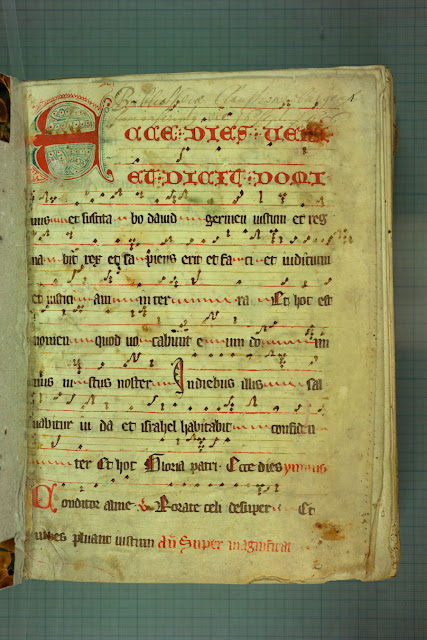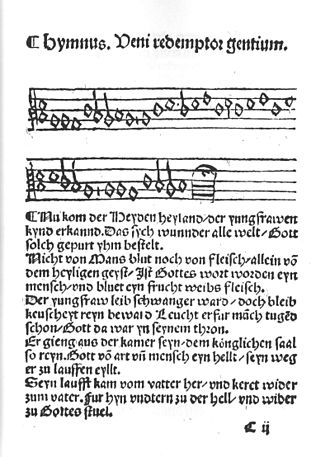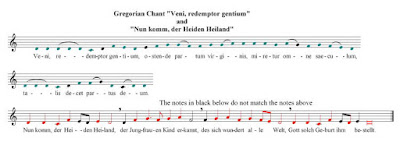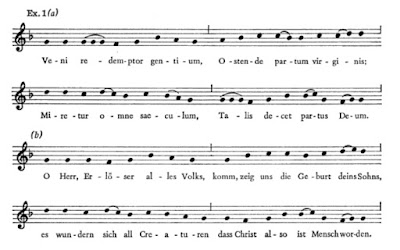Iacet granum oppressum palea is the Third Responsory at Matins in the Sarum Breviary for the Feast of St. Thomas Becket, December 29. But it is also used, sometimes in procession, at the end of (what would normally be Second) Vespers of the Feast of the Holy Innocents - that is, Vespers of the day before the Feast of St. Thomas Becket - and in a very interesting way. More about that below.
First, the chant, beautifully sung here by Egeria Voices, a Spanish a capella group:
Here are the words, in Latin and English:
St. Thomas Becket was the Archbishop of Canterbury who was murdered by soldiers of King Henry II of England in Canterbury Cathedral on December 29 in the year 1170. This was an event that shocked England and all of Europe, and Thomas was canonized only three years later. You can read a full account of the event and its repercussions at the British Museum website. Here's a quote from that page:
The week following Christmas is packed with Feast Days: St. Stephen on December 26; St. John the Evangelist on December 27; Holy Innocents on December 28; St. Thomas Becket on December 29. The liturgies of the week are therefore very complex; each of these feasts has its own antiphons, prayers, responsories, and hymns - and each day includes a sort of First/Second-Vespers-Memorial-mashup of the Feast itself with each following feast day. (These seem sometimes to be referred to as "Memorials," even though Memorials are - as their name would imply - normally a hearkening-back to a feast day that's already happened. Normally major feasts have a First and Second Vespers, too - but one day just tumbles into the next during this week, so it's a bit confusing, and hard to know what to call Vespers during this time!) There are other ordinary memorials throughout the week, too: of Christmas every day, and also memorials for each prior feast. And then each of these feast days has its octave one week later, most falling within the twelve days. It's all very complicated - made more so in emotional resonance by the fact that three of four of these major feast are martyrs' days. In any case it is a very, very rich set of offices.
As I noted above, this chant, Iacet granum oppressum palea, is introduced at the end of Second Vespers of Holy Innocents - then used again at Matins of St. Thomas Becket a few hours later. And, at that First/Second Vespers/Memorial mashup, this chant is also associated with a "Procession to the Altar of St. Thomas."
The set of screenshots below comes from Volume 2 of Prosper Guéranger's "The Liturgical Year"; this Volume contains commentary on the Christmastide liturgies. (It's actually just the first volume of what Guéranger classified as Christmas liturgies. Volume 1 begins at Christmas Eve, and runs through the Vigil of the Epiphany; Volume 2 begins on Epiphany, and runs through and includes Candlemas, and then the following Sundays through Quinquagesima.)
Anyway, here's Guéranger's take on this Responsory and its function; note, too, that the Responsory-plus-Prose is entirely in rhyme in the Latin:
Here's a full description of the celebration of the feast, from an 1894 publication of The Dublin Review, in an article titled The Ancient Offices of Some of England's Saints.
Lots more on all the offices of the day at that article! It's clear that this was a very important day, in the middle of a very important week; the offices are very ornate and rich in every way.
Here is the entire Responsory-plus-Prose / Procession from the Holy Innocents page at The Sarum Rite English Scholarly Breviary; it immediately follows Memorials for Nativity, St. Stephen, and St. John the Evangelist:
The Responsory chant itself was used in many places, from England to France to Czechia to Hungary. See the full list of concordences at the University of Waterloo chant database.
At some point I'll create images for the full Procession score in Latin, too, and will post it here. Also, I would love to find a recording of the Prose section of the chant used at the Vespers memorial; if I too, I'll post that here, too.
First, the chant, beautifully sung here by Egeria Voices, a Spanish a capella group:
Here are the words, in Latin and English:
R. Jacet granum oppressum palea,
Justus coesus pravorum framea,
Coelum domo commutans lutea.
V. Cadit custos vitis in vinea,
Dux in castris, oultor in area,
Coelum domo commutans lutea.
R. The grain of wheat lies smothered by the chaff,
the just man slain by the sword of sinners.
Changing his house of clay for heaven.
V. The vine-keeper dies in his vineyard,
the general in his camp, the husbandman on the place of his toil.
Changing his house of clay for heaven.
St. Thomas Becket was the Archbishop of Canterbury who was murdered by soldiers of King Henry II of England in Canterbury Cathedral on December 29 in the year 1170. This was an event that shocked England and all of Europe, and Thomas was canonized only three years later. You can read a full account of the event and its repercussions at the British Museum website. Here's a quote from that page:
Becket’s death and subsequent miracles transformed Canterbury Cathedral into one of the most important pilgrimage destinations in Europe. In 1220 his body was moved from the crypt to a glittering new shrine in a purpose-built chapel upstairs in the Cathedral. Geoffrey Chaucer famously captured something of the atmosphere of pilgrimage to this shrine in his Canterbury Tales. In death Becket remained a figure of opposition to unbridled power and became seen as the quintessential defender of the rights of the Church. To this end you can find images of his murder in churches across Latin Christendom, from Germany and Spain, to Italy and Norway. Becket was, and remains, a truly European saint. His relics at Canterbury were visited by people from across the continent until 1538, when Henry VIII would label him a traitor, order the destruction of his shrine and try to wipe him from history altogether. That, however, is a story for another time.Here's a page containing this chant, from the Antiphonarium Massiliense, an Antiphoner from Marseille cathedral. It's from the late 12th century, dated to between 1190 and 1200.
The week following Christmas is packed with Feast Days: St. Stephen on December 26; St. John the Evangelist on December 27; Holy Innocents on December 28; St. Thomas Becket on December 29. The liturgies of the week are therefore very complex; each of these feasts has its own antiphons, prayers, responsories, and hymns - and each day includes a sort of First/Second-Vespers-Memorial-mashup of the Feast itself with each following feast day. (These seem sometimes to be referred to as "Memorials," even though Memorials are - as their name would imply - normally a hearkening-back to a feast day that's already happened. Normally major feasts have a First and Second Vespers, too - but one day just tumbles into the next during this week, so it's a bit confusing, and hard to know what to call Vespers during this time!) There are other ordinary memorials throughout the week, too: of Christmas every day, and also memorials for each prior feast. And then each of these feast days has its octave one week later, most falling within the twelve days. It's all very complicated - made more so in emotional resonance by the fact that three of four of these major feast are martyrs' days. In any case it is a very, very rich set of offices.
As I noted above, this chant, Iacet granum oppressum palea, is introduced at the end of Second Vespers of Holy Innocents - then used again at Matins of St. Thomas Becket a few hours later. And, at that First/Second Vespers/Memorial mashup, this chant is also associated with a "Procession to the Altar of St. Thomas."
The set of screenshots below comes from Volume 2 of Prosper Guéranger's "The Liturgical Year"; this Volume contains commentary on the Christmastide liturgies. (It's actually just the first volume of what Guéranger classified as Christmas liturgies. Volume 1 begins at Christmas Eve, and runs through the Vigil of the Epiphany; Volume 2 begins on Epiphany, and runs through and includes Candlemas, and then the following Sundays through Quinquagesima.)
Anyway, here's Guéranger's take on this Responsory and its function; note, too, that the Responsory-plus-Prose is entirely in rhyme in the Latin:
S. Thomas Of Canterbury.
From the day when Henry II. bestowed the crown of martyrdom on his primate, to the day when a still more ferocious Henry rifled his tomb, and threw his sacred ashes to the four winds, no more popular name was to be found in the Calendar of English Saints than that of Thomas Becket.
His festivals, therefore, as may well be imagined, were celebrated with especial splendour, and a more than wonted beauty is to be met with in his offices. Of these the Sarum Breviary gives three varieties.
The office for his festival proper, observed on December 29th, the solemn commemoration for the feast of the translation of his relics, and a weekly commemoration, or, as we should say, votive office.
The celebration of the great festival, December 29th, commenced on the day preceding the feast itself with what was called a memorial.
This memorial was made in two ways. In certain churches, probably the more important, immediately after vespers, and without changing their vestments, the clergy and choir proceeded, in solemn procession, nevertheless, without candles in their hands, as the rubric expressly states, to the altar of St. Thomas, and, as they went, they hymned their hero's victory. "The wheaten grain lies prone before the flail," runs the quaintly beautiful sequence with which Sarum honoured the greatest of England's saints. "The righteous man, hewn down by impious swords, thereby exchanging squalid earth for Heaven. The vineyard's keeper falls beside the vine. The captain on the battle-field lies low, the husbandman within his threshing-floor. From squalid earth, Christ's martyr mounts to Heaven."*
Having reached the altar, this as well as the image of the saint was incensed by the officiating priest, while the rest of the clergy and the choir, grouped around, continued their triumphant canticle:
Sound ye the gladsome trump of victory,
For this, that God's own vineyard might be free,
*R. Jacet granum oppressum palea,
Justus coesus pravorum framea,
Coelum domo commutans lutea.
V. Cadit custos vitis in vinea,
Dux in castris, oultor in area,
Coelum domo commutans lutea.
Which, clad in human flesh, Himself had freed
By dying on the purple blood-stained cross.
The savage beast of prey becomes a lamb,
The shepherd's crnel death converts his foe,
Christ's marble pavement flows all red with blood.
Thus Thomas wins the martyr's laurel crown,
And like the wheaten grain, from husk set free,
Is garnered in the storehouse of the King.*
Then was intoned the V. Ora pro nobis Beate Thoma, &c., with its accompanying R., and afterwards followed the Collect, the same which we still use.
The memorial completed, the clergy returned to the choir; but great was the devotion of the ancient Church of England to the Mother of God. She loved to associate the name of Mary, with all her joys and all her sorrows. In redeundo, runs the rubric, dicitur Responsorium vel Antiphona de Sancta Maria.
In those churches in which it was not customary to have a procession on St. Thomas's Eve, the following antiphon was substituted for the above prose:
The watchful pastor, slain amid his flock,All the antiphons at this office are rhythmical and rhyming.
Their peace procures, by pouring out his blood.
O joyous sorrow! O most mournful joy!
The sheep draw breath, the shepherd lyeth low,
And weeping Mother Church applauds a son
"Who, by his death a victor, mounts to Heaven. +
Those at Matins form a sort of metrical legend of the Saint's life, the chief characteristic of which is quaintness. Several of them, however, are not without a certain naive beauty. Take, for example, the ninth, which sings of the happiness of the place and of the church, in which the memory of Thomas dwells, of the country which gave him birth, and of the land which afforded him shelter during his exile:
Ant. 9.—Felix locus, felix ecclesia:
In qua Thomse viget memoria:
Felix terra quae dedit proesulem
Felix ilia quae fovit exulem:
Felix pater, sucurre miseris:
Ut felices jungamur superis.
________________________________________________
* Prosa.
Clangat pastor in tuba cornea.
Ut libera sit Christi vinea,
Quam, assumptae sub carnis trabea,
Liberavit cruce purpurea,
Adversatrix ovis erronea
Fit pastoris ccede sanguinea,
Pavimenta Christi mamorea
Sacro madent cruore rubea.
Mart ir vitse donatus laurea,
Velut granum purgatum palea,
In divina transfertur horrea
Curium donio commutans lutea.
+ Pastor caesus in gregis medio
Pacem emit cruoris precio.
O loetus dolor in tristi gaudio,
Grex respirat pastore mortuo.
Plangens plaudit mater in filio,
Quia vivit victor sub gladio.
Lots more on all the offices of the day at that article! It's clear that this was a very important day, in the middle of a very important week; the offices are very ornate and rich in every way.
Here is the entire Responsory-plus-Prose / Procession from the Holy Innocents page at The Sarum Rite English Scholarly Breviary; it immediately follows Memorials for Nativity, St. Stephen, and St. John the Evangelist:
The Responsory chant itself was used in many places, from England to France to Czechia to Hungary. See the full list of concordences at the University of Waterloo chant database.
















